Best and easiest way to sprout grains for chickens, BAR NONE!
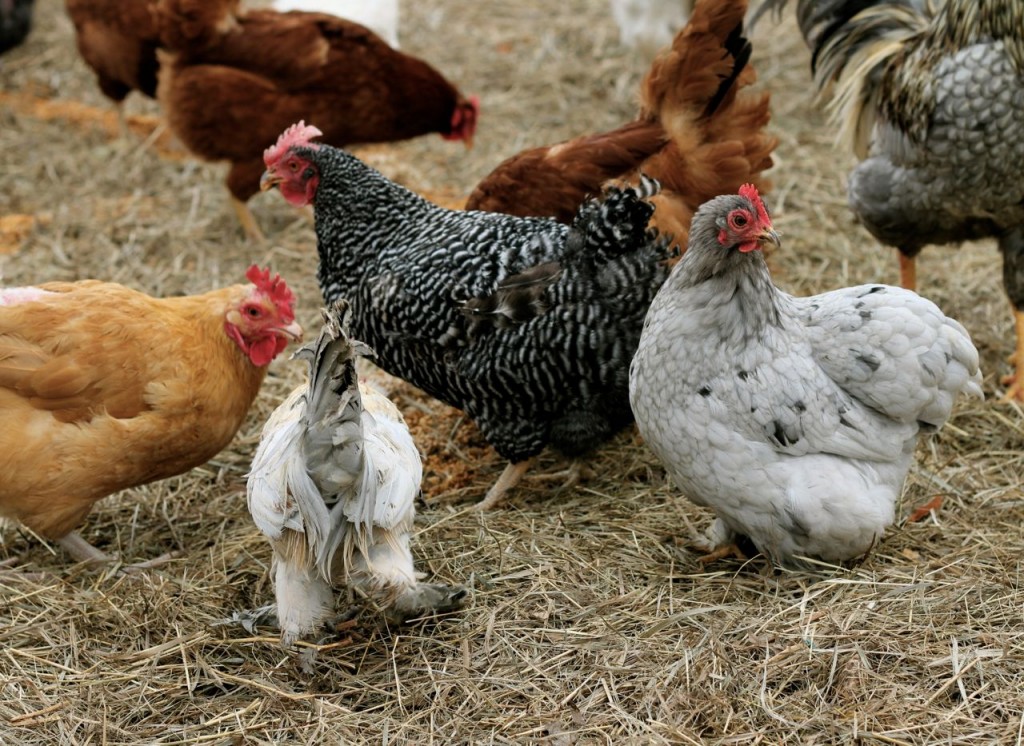
I started sprouting grains for my chooks last year, about this time. I read quite a bit about the process, and developed my own method. It wasn’t much trouble, but it did add a bit of time to the chores every day, more than I would have liked, and I had to keep the buckets of sprouting grains in a spot where there was fresh water available, that is to say, in the main family bathroom. Which wasn’t ideal (cough).
But I felt so great about feeding those sprouts to my little flock, I didn’t mind a bit of hillbilly tactics, even when I had to scramble to hide the buckets of sprouts when we had sudden, unexpected company. I wrote about it all here.
But then this winter I got busy (imagine that), working to get all the melodrama set painted early, so we could go watch my son-in-law-to-be, Saia, compete at Nationals in wrestling the weekend before our Show Week (insane notion, eh?) and so I cut some corners in my sprouting routine, and crossed my fingers, hoping it would work.
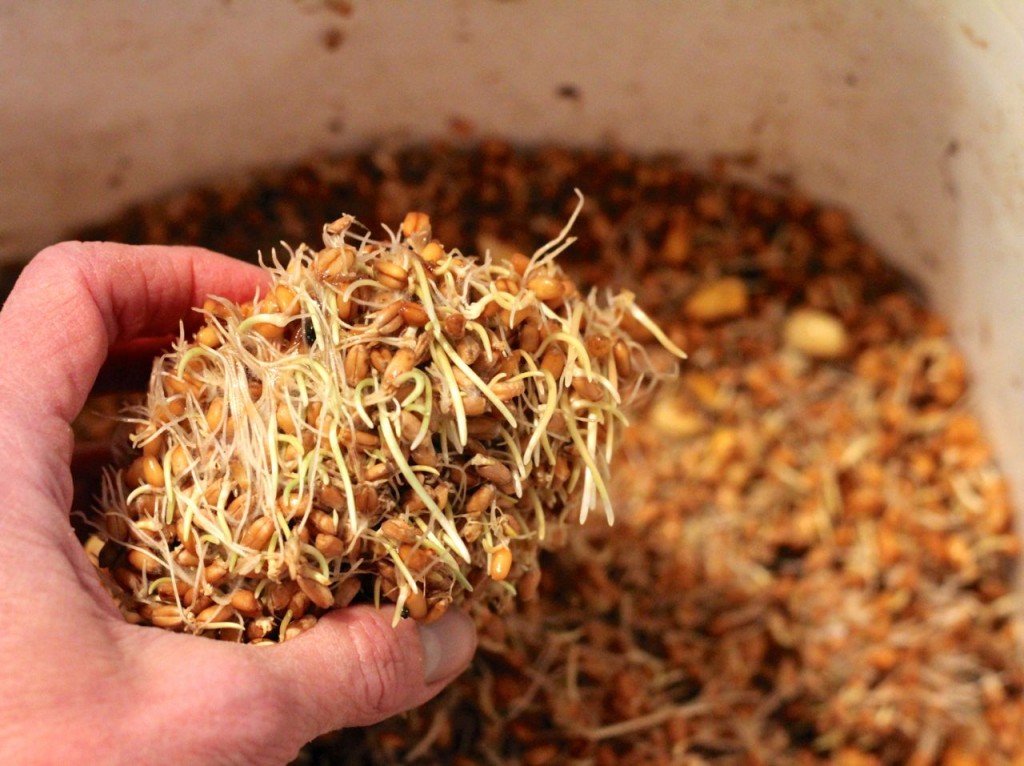
Isn’t this a delightfully pretty handful of sprouts?
Guess what? My streamlined sprouting method works just as well as the more time-consuming method that I had been using. I’m a convert! I’m a convert to the easiest way of sprouting ever! To fermented and sprouting grains, I am a devotee, and so–lucky you, Gentle Reader--of course I will share it with you.
Before I tell you my streamlining secret, here’s a quick reminder of why sprouted grains are such a great addition to your flocks’ breakfast:
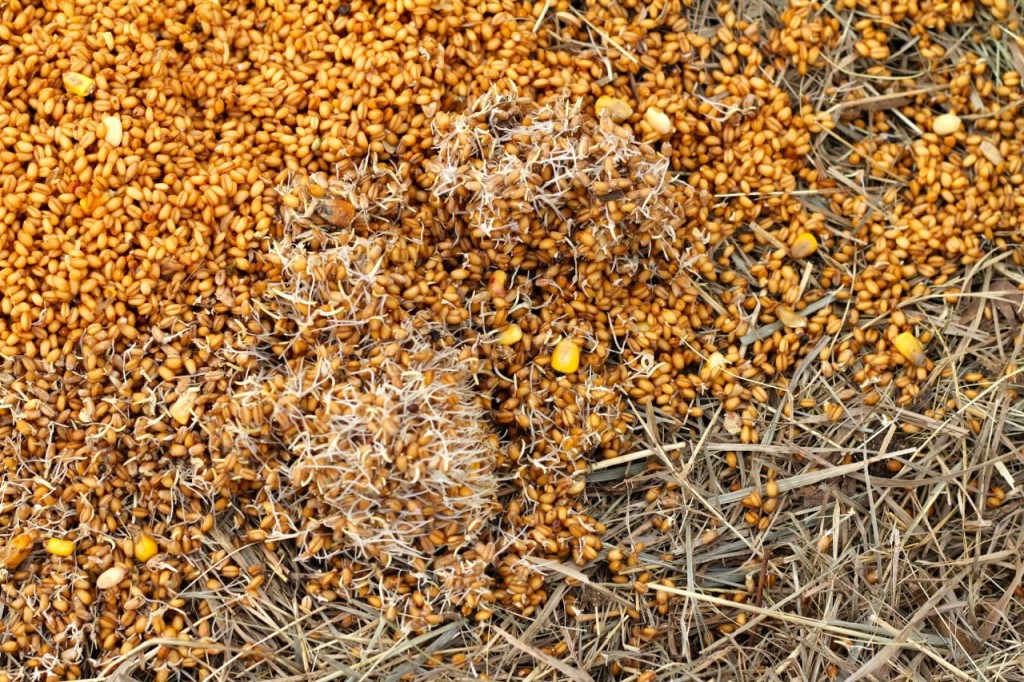
I toss the sprouted grains out on a nice layer of hay in the chooks’ yard. They peck and scratch away at it all the day long, bless them.
Here are the three reasons that I sprout grains for my chooks, and will continue to do so:
- Better nutrition: Did you know that if you let grains sprout, the protein content can jump by 50%, depending on the grain and other factors? Pretty neat trick!
- More grain for your money: the volume of the grains, as they swell up with water and sprout, increases. A half-bucket of dry grains becomes a three-quarters-full bucket of grains, just with the addition of warm water and time. I like the economy of that. It makes me feel smart and savvy. And I like feeling smart and savvy.
- Palatability: Anybody who feeds chickens will notice that fowl rarely clean up dry grains. Here’s something you may not realize: chickens don’t have teeth! Hard, slick grains can be tough for chickens to eat. But not soft, soaked ones.
- One more thing: Did I say three things? I meant four. Sprouting neutralizes phytic acid, which blocks the absorption of many minerals, and it also increases the vitamin content. Here’s a nifty fact: sprouted wheat contains four times the amount of niacin and nearly twice the amount of vitamin B6 and folate as unsprouted wheat. Cool, eh?
- Okay, so I actually meant five things: It takes only minutes a day. That’s it.
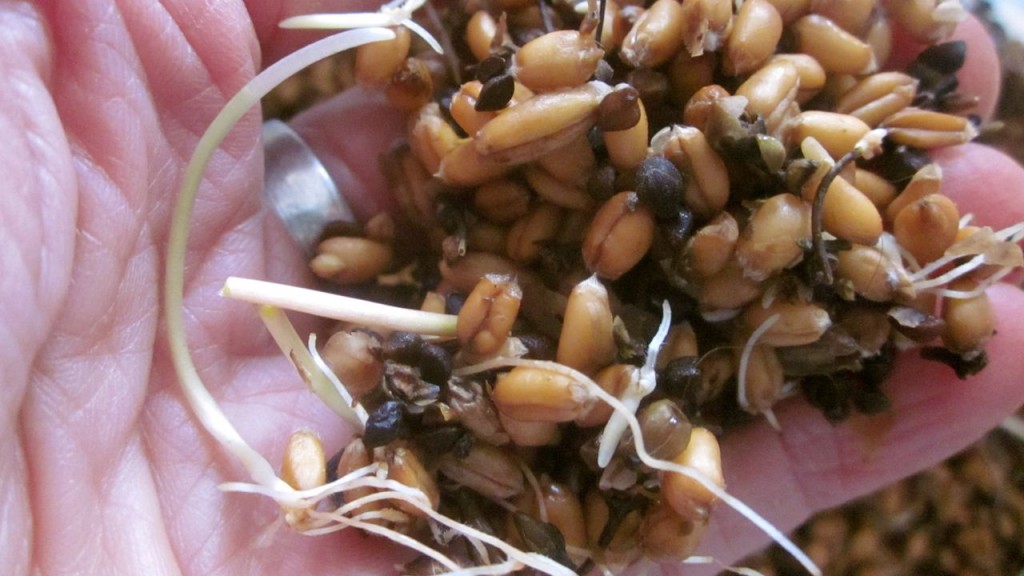
So here it is: The New and Improved Easiest Sprouting Method Ever, invented by (ta-daaa!) Yours Truly. (Who Enjoys Using Caps in Headings as Much as Possible.) (And is Smart and Savvy.) (And likes fiddling around with bold letters and italicizing things.)
1. First, buy your grains someplace where they don’t run them through a heated dryer. (Heated grains won’t sprout.) We are lucky that our local Coop will allow us to pull up a trailer full of large trash bins, hillbilly-like (I even have my banjo in the front seat with me, picking away) and they’ll fill them with their cool apparatus (you think I’m kidding about the banjo?), straight from the grain bin itself. (Bryan does the grinning.) (Actually he wears a very large hat and sunglasses. And a weird disguise. I’ve no idea why he does this.) (Hey, a girl has got to practice!) (Somebody stop me.)
2. Fill two or three 5-gallon buckets three-quarters-full of grains. Pour warm water into the bucket, just to cover. Too much water and the grains won’t absorb it all. Too little, and the grains on the top won’t sprout. It’s not brain surgery, but you’ll see that there is a perfect amount.
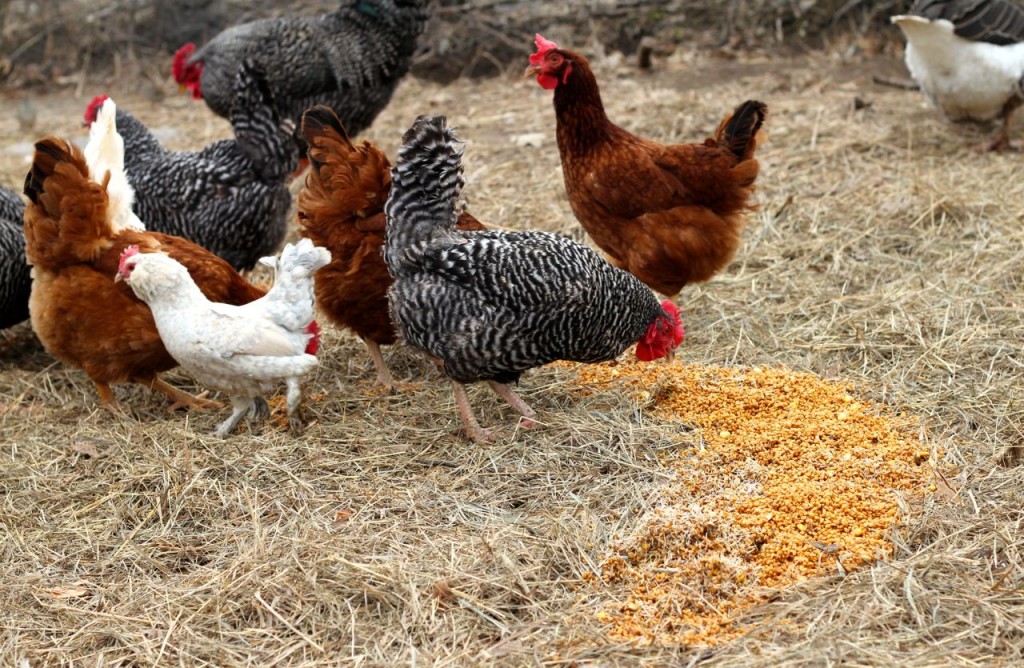
My chickens really clean up these sprouted grains! I can just hear them smiling over them. Wait–
3. Let sit for 24 to 36 hours, in a warmish place. I haul mine down to the basement, so we aren’t tripping over them on the main floor. This extra step saves me my pride, when visitors stop by. Unless the kitty is in heat and is . . . er . . . doing her thing right in front of them, which is what would happen if you stopped by today.
4. Dump the soaked grains (once again, there shouldn’t be much–if any–water visible now) the next day into two or three fresh buckets. Each bucket should be about a third or half-full of soaked grains now. If the top grains are very dry, add just a bit more warm water. Reducing the bulk in each bucket allows the grains to grow more freely. (You can use dishpans, too, although then they aren’t quite as handy to haul out to the chicken yard.) If you have tons of buckets, you can reduce the amount even more–say, pour them only one-quarter-full, and you’ll have even more sprout growth.
5. Let sit in a warm(ish) place for two or three days. Every day, pick up your buckets one by one and jiggle them a bit, to separate the grains.
6. When you see the sprouts growing, your sprouts are ready to toss to your chickens! I’ve let them sit for up to a week, and those little sprouts just grow and grow. The handful of sprouts in the photo at the top of this post are probably 5 or 6 days old.
7. Just watch those chickens grin! 🙂
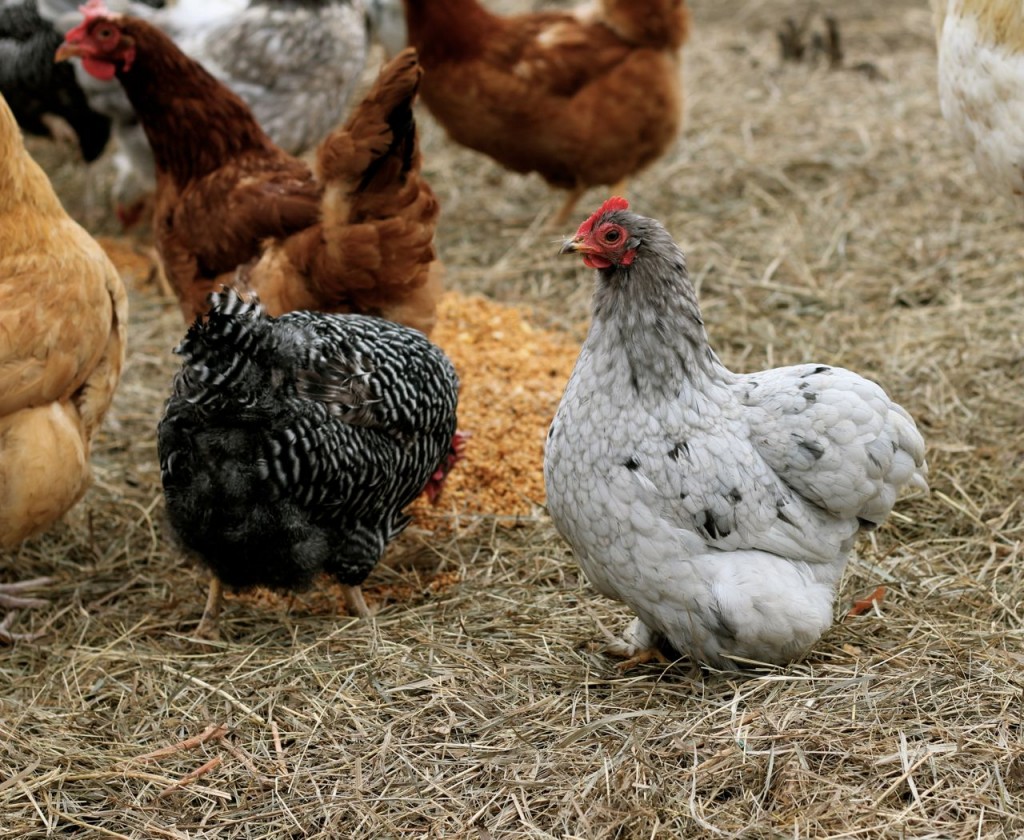
Here’s our favorite hen (shhh–don’t tell the others!), Babes, enjoying the anticipation of breakfast, but taking a second to pose decorously for a portrait, before she dives in. Only one of the many reasons that she is our favorite.
That’s it! Isn’t it easy? I’ve actually got a row of buckets of growing sprouts in my basement, enough feed for the next week or two. Yep. Who is smart and savvy?—-> 🙂 me

Here’s my motley assortment of buckets, tucked away in the basement.
And now, by association, dear Gentle Reader, you are smart and savvy, too!
Now go. Get busy and sprout your grains, but before you do–could you take just a moment and share this post with somebody in your life who might benefit from it? And as always, thank you for reading and sharing!
ALSO!! Want to learn more obscure and yet practical tips and tricks about raising chickens, borne out of over a decade and a half of raising chickens by some ole chicken lady (me!)?? Well, then, chickie, scoot on over here and buy my new ebook. You’ll love it!
–and *hugs*–
. . . aaaand if you need to do a bit of shopping today . . . would you consider using my link below? Your purchases won’t cost a penny more, and you’ll be helping to support my blogging efforts. (Thank you in advance!)


What a great post! We sprout seeds for our own use and for our animals. I like your bucket method–it’s similar to what we do. Thanks for sharing!
You have some gorgeous furry friends! And my hat’s off to you for making such a great treat.
Thanks Carol. Aren’t they sweet?
There are times I wish we lived on acreage so we could raise things like this. I would love to have ducks to watch over!
Ducks are the cutest things ever, Scott! We have kept them in the past, but their weakness to stay on the pond at nights (instead of in the safety of their little house) makes them very attractive prey to the local predators! 🙁
I love that you did this – and systems in place for healthy happy ‘chooks’! But, also I’m sure you get so many benefits from it – and they are just so beautiful the ‘chooks’ and the sprouting grains for for your ‘chooks’!
Since I already posted – I’ll share you great story!!
Thanks Donna!
Aren’t they pretty, Donna? They know that they are spoiled rotten!
What type of grains do you use? (asks my chook owning coworker since her chooks turned their beaks up at radish sprouts)
I can’t imagine chickens turning up their beaks from ANY sort of sprouts, Cindi! That beats all! But I have sprouted all kinds of grains–I get organic grains–barley, wheat, and weed seeds–from a local supplier, but lately I’ve been getting wheat from the local Coop, which is closer, and cheaper. There are a few corn seeds mixed in, too, I’ve noticed. Do you have a Coop in your area? I’d call and see what they have available.
Do you cover your buckets? In the picture it looks like they are uncovered, but I want to make sure. I love our hens and roos <3
No, Therese, I don’t cover the buckets.
As soon as I m cleared to lift more than pounds I am doing this!
This is another great article that I will share with Maria as soon as she gets home. She went swimming in the river that runs by the farm, she will love the idea and we do have the buckets.
She also wanted to ask you why the hens are laying a lot of triple yokers lately?
One of the hens gave us 7 new babies this morning so we are still around 100 perhaps a little more.
We added about a foot of fresh soil to their play area this past week and put in a new drain system because of the tropical rains we get out here.
Chef, it sounds like you are really busy down there!! Triple yolks: I’d say you are doing something right! Those are happy hens and they are getting great nutrition, to be such overachievers! Congrats on the new chicks!!
Just a suggestion for those in warmer climates. You only need to soak the grain for around 4 hours or it will begin to ferment. You’ll need to rinse them thoroughly twice a day and don’t overload them. I feed my chooks sprouted wheat everyday and rarely give them any hard seed. I sprout the wheat in plastic strainers and also large aluminium foil trays with plenty of small holes punched through. Be vigilant in checking for mould. In warm climates they will be sprouting within 24 hours. Mine rarely get to day 3 because my chooks eat so much sprouted wheat.
Do you feed the sprouted grain in place of store-bought chicken feed, or in addition to it?
I feed it in addition to the store-bought chicken feed. I present my spoiled hens with their choice of a mixture of layer crumbles and cracked corn, oyster shell, and sprouted grains. They seem to enjoy it all! Oh, I also give them any garden weeds that I’ve pulled (during the growing season) and any kitchen scraps, eggshells, etc. (usually about a gallon bucket full).
Thank you for this great article. I am curious do you buy a mix of different grains or just wheat? Thank you!
Julien,
Great question! I use whatever grains I can find at a cheap price, ha! At the grain elevators that are close to me, I can buy only wheat and cracked corn in bulk quantities. There is an organic elevator that is farther away, and I’ve purchased all types of grains from them in bulk, “screenings” they call them and they are also a good price. I’ve also purchased barley from a fellow who makes compost and snagged it very cheaply from the landfill! If you ask around in your area, you might be surprised what grains you find! I’d try a small quantity to begin with, and watch your chickens closely to see if they like them. For example: my chooks will eat soaked whole corn kernels, but they aren’t crazy about them. They really gobble up the wheat and barley, though.
Do you supplement with layer pellets, etc. or do the birds get a full tummy and a sufficiency of protein and other nutrients from the sprouted grain?
Steve, such a great question! I do supplement with layer feed, but I don’t offer very much of it, especially during the growing season when the flock really prefers to go out and eat grasses, weeds, and bugs. They’ve always thrived with this feeding routine. I also throw a lot of excess garden produce and weeds and even grass clippings to them. They’re pretty spoiled, actually!
Pingback: 15 Ways to Reduce Duck Feed Costs — Raising Ducks - Animal Favorite Foods